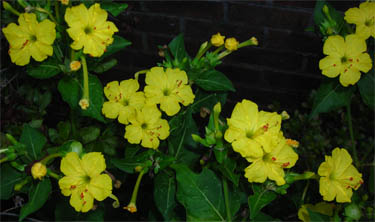















Magnolia Eden
Four O' Clocks
Timeless Heirloom Flowers Right at Home in the South
Timeless Heirloom Flowers Right at Home in the South
Available in white, yellow, pink, red and mixed, the flowers of Mirabilis jalapa (commonly known as four o'clocks or Marvel of Peru) open in late afternoon/early evening and close the following day before noon, living up to the plant's latin translation: marvelous or astonishing. A perennial from tropical America, the Mirabilis jalapa is cultivated in the United States as an annual except in USDA Zones 8-11 where it thrives as a perennial. Heat- and drought-tolerant, four o'clocks are easily grown from seed and will often return from tubers year after year where winters are relatively mild. Growing two to four feet in height, the plants prefer full sun and tolerate a variety of well-drained soils.
Mirabilis jalapa is particularly suited for the quaint cottage gardens for which the rural American South is known, but the plant also deserves a rightful place in formal locales where it is capable of adding interest and contributing a vibrant kaleidoscope of color at a time of day when many other flowers are fading or well spent. Four o'clocks can even be found growing at historic Monticello Plantation, Thomas Jefferson's estate in Albemarle County, Virginia. Upon observing the flowers in his garden, Jefferson noted in July 1767, "Mirabilis just opened, very clever." Monticello's records further indicate that seed were received from André Thouin of the famous Jardin des Plantes in Paris in 1811.
Mirabilis jalapa is particularly suited for the quaint cottage gardens for which the rural American South is known, but the plant also deserves a rightful place in formal locales where it is capable of adding interest and contributing a vibrant kaleidoscope of color at a time of day when many other flowers are fading or well spent. Four o'clocks can even be found growing at historic Monticello Plantation, Thomas Jefferson's estate in Albemarle County, Virginia. Upon observing the flowers in his garden, Jefferson noted in July 1767, "Mirabilis just opened, very clever." Monticello's records further indicate that seed were received from André Thouin of the famous Jardin des Plantes in Paris in 1811.


It's no wonder the plant that awed Jefferson over two centuries ago continues to impress gardeners today. Wonderfully fragrant, the blooms perfume the air, making four o'clocks ideal for planting near patios, decks, screened porches and backyard swings where they can be enjoyed to the fullest extent while conversing with family or friends, sipping iced tea or lemonade and hopefully relishing an evening breeze.
The downside to the prolific bloomer is its abundant crop of seed. Judicial culling of unwanted seedlings each spring and digging of tubers each fall might prove necessary, but inevitably some seedlings will be overlooked and portions of tubers often remain undug and subsequently new plants emerge. Mirabilis jalapa is best planted in containers of generous size or situated in a bed where it can freely colonize.
The downside to the prolific bloomer is its abundant crop of seed. Judicial culling of unwanted seedlings each spring and digging of tubers each fall might prove necessary, but inevitably some seedlings will be overlooked and portions of tubers often remain undug and subsequently new plants emerge. Mirabilis jalapa is best planted in containers of generous size or situated in a bed where it can freely colonize.
These all-yellow Mirabilis jalapa growing in the author's garden are descendants of plants first introduced to the property more than two decades ago. Occasionally, red and red/yellow splashed blooms appear.
Fun for the Whole Family
In a July 13, 2007 article for the Dallas Morning News, writer Bill Scheick stated, "When Joseph Breck, founder of the famous seed company bearing his name, published The Young Florist in 1833, his goal was to introduce children to the recreational and spiritual benefits of gardening. He ranked four o'clocks (Mirabilis jalapa) high on his list of unusual plants likely to rouse children's curiosity."
Mr. Breck had a good point, and his philosophy rings true today. In addition to its unique blooming characterisitcs and ease of care, Mirabilis jalapa is likely to appeal to inquisitive youngsters with a green thumb because of its ability to attract hummingbird-like sphinx moths that feed after dark on the sweet nectar of its trumpet flowers. Further, seeds from the plant are easily collected and stored for planting the following spring, providing valuable educational opportunities for boys and girls as they learn about seed germination and plant cultivation.
The spherical seeds are black and wrinkled upon maturation, and should be dried and stored in a paper envelope. Properly label the envelope, identifying its contents and recording the date. For extra protection, seal the envelope in a plastic bag and keep in a cool, dry place. As soon as the ground can be worked the following spring and all danger of frost has past, seeds may be sown and covered with 1/4 inches of soil. Germination typically takes about a week.
Selections and Sources
Gardeners can choose from a variety of strains, and sources include fellow gardeners and a host of retailers. Regarded as an heirloom, seeds of Mirabilis jalapa can often be obtained from relatives and friends, but a perusal of classified advertisements in publications like state agricultural bulletins might prove fruitful in one's search for seeds. As for commercial seed companies, two southern-based institutions stand out. Nationally known George W. Park Seed Company in Greenwood, South Carolina, is one of the oldest and largest family-owned mail-order seed companies in America. Its offerings include 'Broken Colors', a variety admired for its range of colors splashed or marbled in red, and 'Limelight', a stunning plant boasting lime-green foliage and fuchsia blooms. The Fulton, Kentucky-based Ferry-Morse Seed Company, founded in 1856, is noted for its point of purchase seed displays in small, independent feed & seed stores and garden centers. The company offers a mixed color seed pack that will render plants adorned in an array of colors including white, yellow, pink and shades of red. Other strains worth locating from other sources include the crimson 'Red Glow', the all-white 'Alba' and the white, yellow and bicolor 'Custard and Cream'.
Always affordable and widely available, Mirabilis jalapa has certainly not lost its prevalence in the South, but it is often overshadowed by more popular annuals. Since the arrival of 2008 seed catalogues is just around the corner, perhaps now is a good time for southern gardeners to reconsider this splendid plant. No doubt, its presence in the garden next summer can prove rewarding.
In a July 13, 2007 article for the Dallas Morning News, writer Bill Scheick stated, "When Joseph Breck, founder of the famous seed company bearing his name, published The Young Florist in 1833, his goal was to introduce children to the recreational and spiritual benefits of gardening. He ranked four o'clocks (Mirabilis jalapa) high on his list of unusual plants likely to rouse children's curiosity."
Mr. Breck had a good point, and his philosophy rings true today. In addition to its unique blooming characterisitcs and ease of care, Mirabilis jalapa is likely to appeal to inquisitive youngsters with a green thumb because of its ability to attract hummingbird-like sphinx moths that feed after dark on the sweet nectar of its trumpet flowers. Further, seeds from the plant are easily collected and stored for planting the following spring, providing valuable educational opportunities for boys and girls as they learn about seed germination and plant cultivation.
The spherical seeds are black and wrinkled upon maturation, and should be dried and stored in a paper envelope. Properly label the envelope, identifying its contents and recording the date. For extra protection, seal the envelope in a plastic bag and keep in a cool, dry place. As soon as the ground can be worked the following spring and all danger of frost has past, seeds may be sown and covered with 1/4 inches of soil. Germination typically takes about a week.
Selections and Sources
Gardeners can choose from a variety of strains, and sources include fellow gardeners and a host of retailers. Regarded as an heirloom, seeds of Mirabilis jalapa can often be obtained from relatives and friends, but a perusal of classified advertisements in publications like state agricultural bulletins might prove fruitful in one's search for seeds. As for commercial seed companies, two southern-based institutions stand out. Nationally known George W. Park Seed Company in Greenwood, South Carolina, is one of the oldest and largest family-owned mail-order seed companies in America. Its offerings include 'Broken Colors', a variety admired for its range of colors splashed or marbled in red, and 'Limelight', a stunning plant boasting lime-green foliage and fuchsia blooms. The Fulton, Kentucky-based Ferry-Morse Seed Company, founded in 1856, is noted for its point of purchase seed displays in small, independent feed & seed stores and garden centers. The company offers a mixed color seed pack that will render plants adorned in an array of colors including white, yellow, pink and shades of red. Other strains worth locating from other sources include the crimson 'Red Glow', the all-white 'Alba' and the white, yellow and bicolor 'Custard and Cream'.
Always affordable and widely available, Mirabilis jalapa has certainly not lost its prevalence in the South, but it is often overshadowed by more popular annuals. Since the arrival of 2008 seed catalogues is just around the corner, perhaps now is a good time for southern gardeners to reconsider this splendid plant. No doubt, its presence in the garden next summer can prove rewarding.
BIBLIOGRAPHY
Joseph Breck, The Young Florist (Boston: Russell, Odiorne & Company, 1833).
Bill Scheick, "It's time again for four o'clocks," Dallas Morning News, July 13, 2007.
Joseph Breck, The Young Florist (Boston: Russell, Odiorne & Company, 1833).
Bill Scheick, "It's time again for four o'clocks," Dallas Morning News, July 13, 2007.
Author: Greg Freeman. Published August 11, 2007.
Copyright
Southern Edition
All Rights Reserved
Southern Edition
All Rights Reserved
All materials contained on this site, including text and images, are protected by copyright laws and may not be reproduced without prior written permission from the publisher. Where applicable, use of some items contained on this site may require permission from other copyright owners.
Fair Use of text from SouthernEdition.com is permitted to the extent allowed by copyright law. Proper citation is requested. Please use this guide when citing a Southern Edition article.
Contact Greg Freeman or SouthernEdition.comFair Use of text from SouthernEdition.com is permitted to the extent allowed by copyright law. Proper citation is requested. Please use this guide when citing a Southern Edition article.